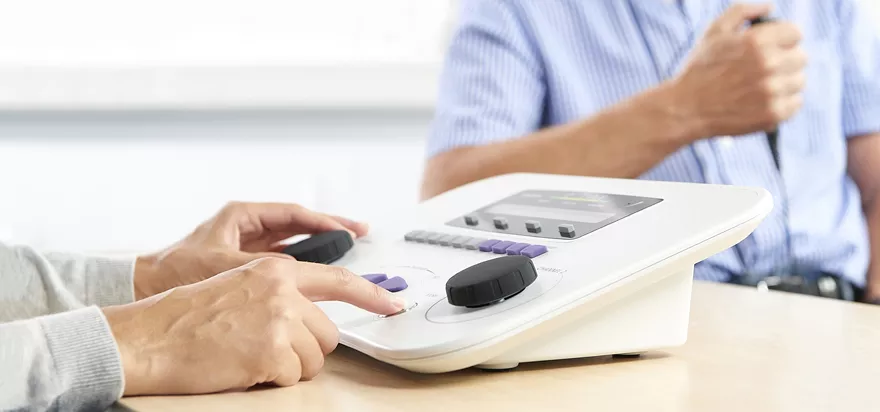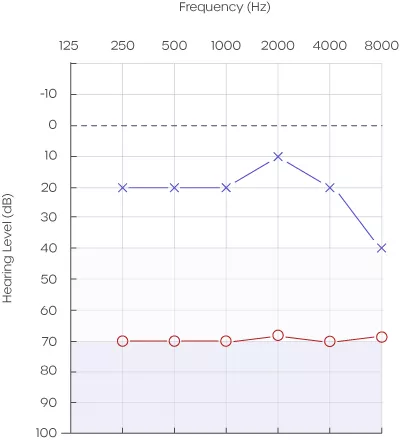There will be a time in any hearing professional’s career when they have a patient who is not responding at the threshold and exhibits a nonorganic hearing loss.

Image Credit: Amplivox
This type of hearing loss, also known as functional hearing loss and pseudohypacusis, involves a reduction in the hearing ability which is not explained by any anatomic or physiologic irregularities (or either)1. One effective behavioral tool for assessing whether unilateral hearing loss is nonorganic is the Stenger test.
What is the Stenger test?
The Stenger test operates on the principle, “when two tones of the same frequency are simultaneously presented to both ears, only the louder tone is perceived.”2
This is when the same sound (tone or speech) is presented at the same time to each ear, and the patient cannot recognize the sound that is being heard by both ears. Stenger testing is typically conducted using an audiometer but can also be performed using tuning forks.
Tone Stenger testing
Stenger testing can be conducted for tones when there is a clear gap of 20 dB or more between ears at any given frequency (presented in Figure 1).

Figure 1. Example of Asymmetrical hearing loss in the right ear. Image Credit: Amplivox
In this case, the patient exhibits a 20 dB or more difference from 250-8000 Hz, necessitating a Stenger test at each frequency.
Testing procedure
The procedure may vary based on the audiometer in use. The majority of modern audiometers will either have a Stenger button or a drop-down menu on the computer/audiometer screen, allowing the selection of Stenger testing.
Upon choosing the Stenger test, identical tones will be presented to both ears. Once the Stenger test is chosen:
- Increase the tone in the better ear by 10 dB from the obtained threshold (for example, 500 Hz in the left ear increased to 30 dB).
- Decrease the tone in the poorer ear by 10 dB from the original threshold (for example, at 500 Hz the right ear decreased to 60 dB).
- By pressing the presentation button, the tones will be presented to both ears.
Negative Stenger
A negative Stenger occurs when the patient raises their hand during the simultaneous presentation of the tone to both ears.
This indicates that the patient is correctly hearing and responding to the sound in the ear. This result supports the accuracy of the recorded response in the poorer ear, and this also indicates the absence of nonorganic hearing loss.
In the example mentioned above, a Stenger test must be conducted at all other frequencies in which a 20 dB difference or more is observed. This ensures accurate responses across all frequencies.
Positive Stenger
In the case of a positive Stenger, the patient does not raise their hand when the tone is played simultaneously to both ears. This indicates that the patient hears the sound in the poorer ear and can discern that it is softer than the earlier “threshold,” resulting in a lack of response as they perceive it to be softer.
When a positive Stenger occurs, it suggests a nonorganic hearing loss. Further testing can be conducted to gather more information about the hearing threshold in the poorer ear.
Minimum contralateral interference level
The minimum contralateral interference level (MCIL) is the lowest level at which the Stenger effect can be achieved. According to Martin and Clark (2019), the responses might be within 20 dB of the patient’s real threshold. To determine MCIL, proceed with the Stenger test:
- In the better ear, adjust the intensity level to 10 dB above the threshold.
- In the poorer ear, set the intensity level at 0 dB.
- Present the tone.
- If the patient responds, progressively raise the intensity of the tone in the poorer ear by 5-10 dB. Take note of the intensity where the patient stops responding, this is considered as the MCIL.
Keep in mind that the patient should ALWAYS respond as they will always be hearing the tone in the better ear.
Stenger Speech testing
Stenger speech testing can also be conducted on certain audiometers with speech material. Speech Recognition Threshold (SRT) tests utilize spondaic words to determine the thresholds for speech reception.
Once obtained, a gap of 20 dB or more exists between the ears, and a speech Stenger test can be conducted, similar to the tone Stenger testing.
It is always advisable to repeat instructions to the patient. However, if their response does not improve after providing the instructions again, it is recommended to utilize objective tests that do not rely on patient participation to further validate the Stenger results.
Objective tests, including Acoustic Reflex Testing, Otoacoustic Emissions, and Auditory Brainstem Response testing, can offer additional validation and provide valuable insights into potential unilateral hearing loss.
Diagnostic audiometers
Amplivox has created a collection of advanced and user-friendly diagnostic audiometers to identify various hearing loss conditions.
The Model 270+ stands out as a sophisticated two-channel diagnostic audiometer with specialized tests like SISI, Stenger, MLB, Master Hearing Aid (MHA), Hearing Loss Simulator (HLS), and tone decay. This makes it an ideal selection for audiologists, ENTs, and hearing aid suppliers within audiology.
References and further reading
1Lin J, Staecker H. Nonorganic hearing loss. Semin Neurol. 2006 Jul;26(3):321-30. doi: 10.1055/s-2006-945518. PMID: 16791778.
2Martin, F. N., & Clark, J. G. (2019). Introduction to Audiology. Pearson.
About Amplivox
Amplivox creates a healthier future by providing accessible and accurate medical solutions for everyone.
As a manufacturer with more than 90 years of experience, we are proud to be a trusted partner to hearing and occupational health professionals all over the world by delivering a high level of knowledge-led solutions, service and support. We are here to be your preferred audiological and occupational health equipment provider.
Sponsored Content Policy: News-Medical.net publishes articles and related content that may be derived from sources where we have existing commercial relationships, provided such content adds value to the core editorial ethos of News-Medical.Net which is to educate and inform site visitors interested in medical research, science, medical devices and treatments.